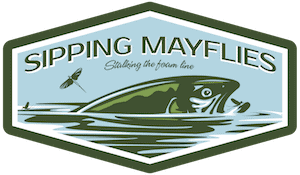What is a BWO in Fly Fishing – BWO Fly Tactics
Feb. 17th, 2022
If you’re wondering what a BWO is, you’ve come to the right place. A blue winged olive (BWO) is a flying insect in the mayfly family that is often associated with river hatches and rising fish, specifically trout.
I’ll explain to you exactly what they are, how to identify them (including pictures), their life stages, and how to fly fish with BWO patterns.
Every fly angler needs to understand blue winged olives and the role they play in fly fishing. If you haven’t experienced a BWO hatch, you’re missing out.
And with that, let’s dive in.
What is a BWO?
BWO is an acronym that stands for “blue winged olive,” the common name of the most prominent mayfly in fly fishing. Blue winged olives (BWOs) are in the genus baetis, of the family baetidae and ephemerellidae. Their name is derived from the fact that they have blue wings and olive bodies.
Blue winged olive mayflies have gone by many names in the past, including olive quills, blue duns, and olive duns. Any time you hear a fly angler mention “baetis,” they’re talking about blue winged olives.
As I mentioned, BWOs can be identified by their olive bodies and blue wings, but in flight they often appear beige in color.
Adult blue winged olives can vary in size, but if I were to describe their dimensions in everyday terms, I’d estimate that they can be as small as a pencil eraser, and as big as a marble.
Here’s a picture of a BWO I caught while fly fishing on a river in California during a hatch. These river bugs are a beautiful sight to a fly angler.
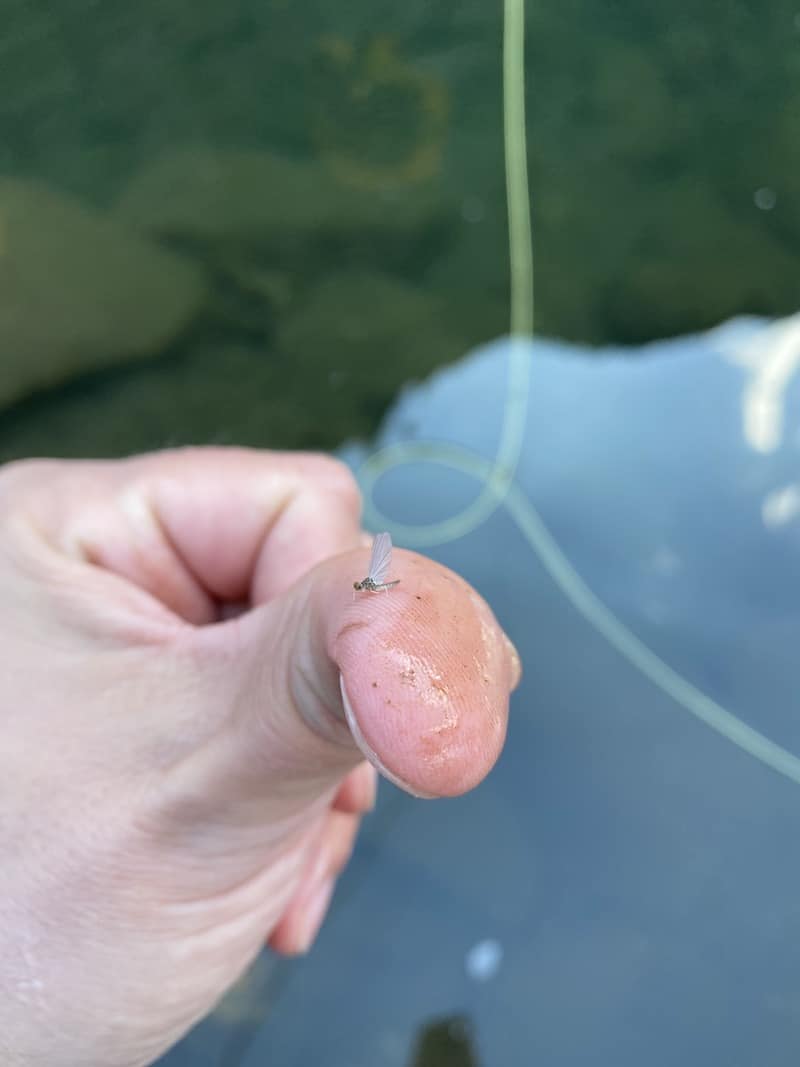
Blue Winged Olive (BWO) Life Stages
Blue winged olive hatches occur year-round, making them one of the most prolific insects on the river. (They share this accolade with midges.) If you could only learn about one fly fishing bug, I’d strongly suggest it should be the blue winged olive (BWO).
BWOs have three life stages: nymph, emerger, and adult.
BWO Nymphs
Blue winged olives are tiny mayflies, but they lay a ton of eggs–sometimes many thousands.
Here’s an amazing video showing a female mayfly releasing her eggs into the water. This species, Cloeon cognatum, is ovoviviparous meaning the eggs develop inside the female. As a result, you’ll notice that the eggs start hatching just one minute after being expelled. It’s the most satisfying video you’ll see all week, especially if you’re into fly fishing.
Blue winged olives are the only mayflies that hatch throughout the winter season, making them favorites with winter fly fishing aficionados.
I often watch females dive down and drag their abdomen across the water’s surface, dropping eggs into the river as they fly. They’re very graceful insects.
Around two weeks later when the eggs hatch, the tiny baetis nymphs will swim to the bottom of the river to find cover and begin feeding on microscopic food items.
They’ll develop a tough exoskeleton, and will molt many times as they grow. These nymphs can often be found living on (or under) submerged river rocks, in gravel, and also on vegetation.
BWOs can swim, but they don’t excel at it. They generally rely upon deliberate drifts to maneuver to new areas.
The nymphs fully develop around one year later. It can be sooner, or later, but an annual cycle is most common. The nymphs must make their way to the water’s surface by drifting, crawling, or with the aid of tiny air bubbles they gather.
Once they reach the surface of the river, they’re officially referred to as emergers.
BWO Emergers
BWO nymphs that reach the surface must now emerge (ie. molt) from their exoskeleton, also called a “shuck.” Blue winged olives float on the surface of the water as they emerge from their shuck, which means they’re completely defenseless and thus very vulnerable to rising trout.
During hatches, feeding trout rise to the surface and consume these helpless emergers.
BWO emerger fly patterns always have material tied at the rear that’s designed to sink below the water’s surface, imitating a shuck.
Out of the exoskeleton emerges a mayfly, complete with wings.
Once the BWO successfully emerges from its shuck, it’s a waiting game. They have to bide their time until their wings dry, while trout are picking them off en masse. It’s a good thing their brains aren’t capable of processing terror.
When their wings are finally dry, which takes just a few minutes, they begin their adult phases.
BWO Adults
Dry wings mean the blue winged olive can now take flight. They’re now referred to as duns (or subimago).
As duns, they fly to a safe area where they can complete their final molt. This transformation takes several hours. Once this molt is complete, they’re then referred to as spinners, or imago.
As spinners, their job is to mate, lay eggs, and die. This process usually lasts for several hours, but mating on two consecutive days is possible.
A year of growth for a day or two of life above water.
Here’s a large brown trout (Salmo trutta) I landed on a size 20 blue winged olive dry fly (adult phase). I wrote an article on brown trout fly fishing that you may want to check out.
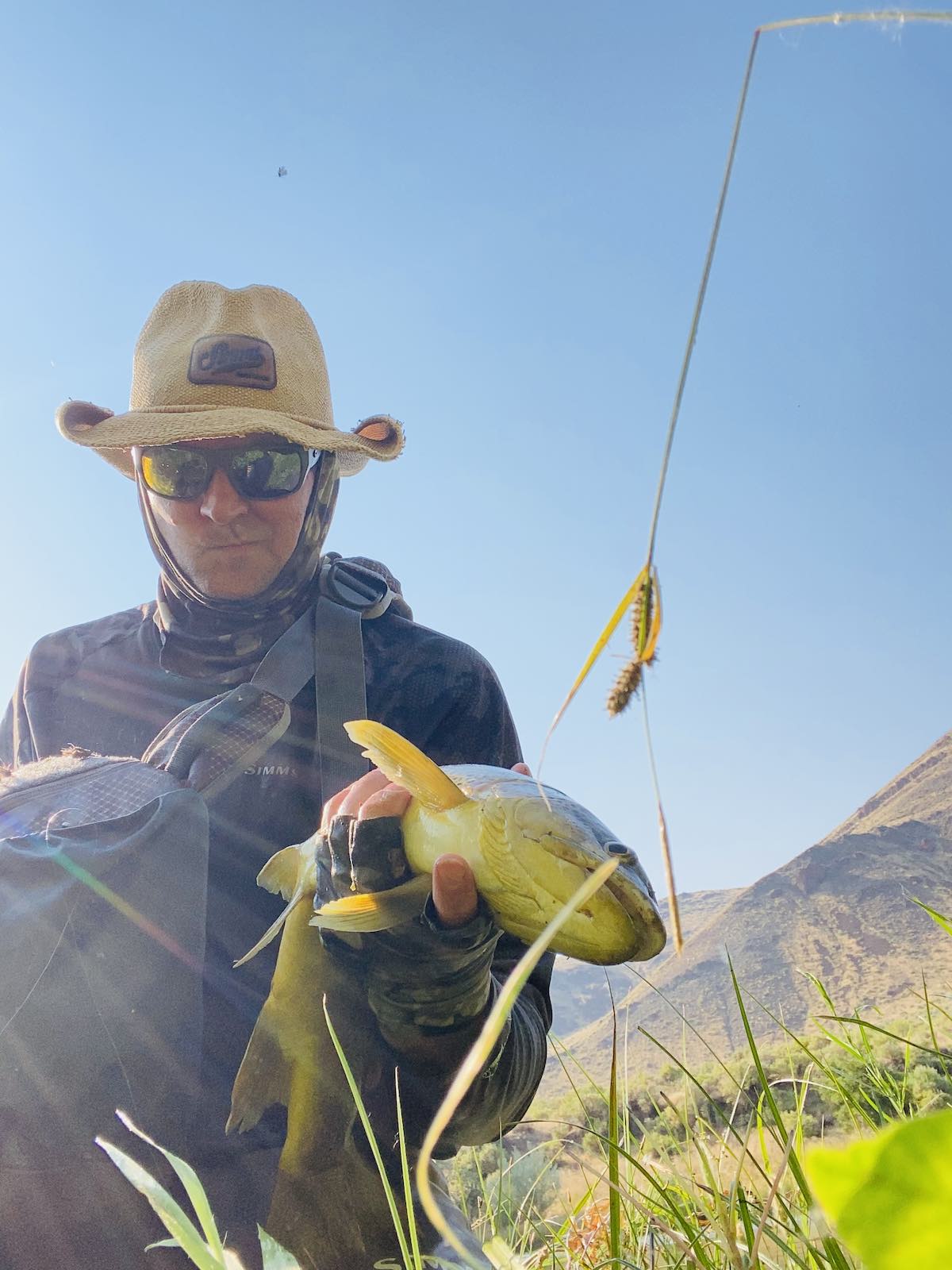
In the below picture you can see a huge blue-winged olive hatch cloud I observed while casting flies for trout. All the light-colored dots are bugs, and there must’ve been many tens of thousands of them.
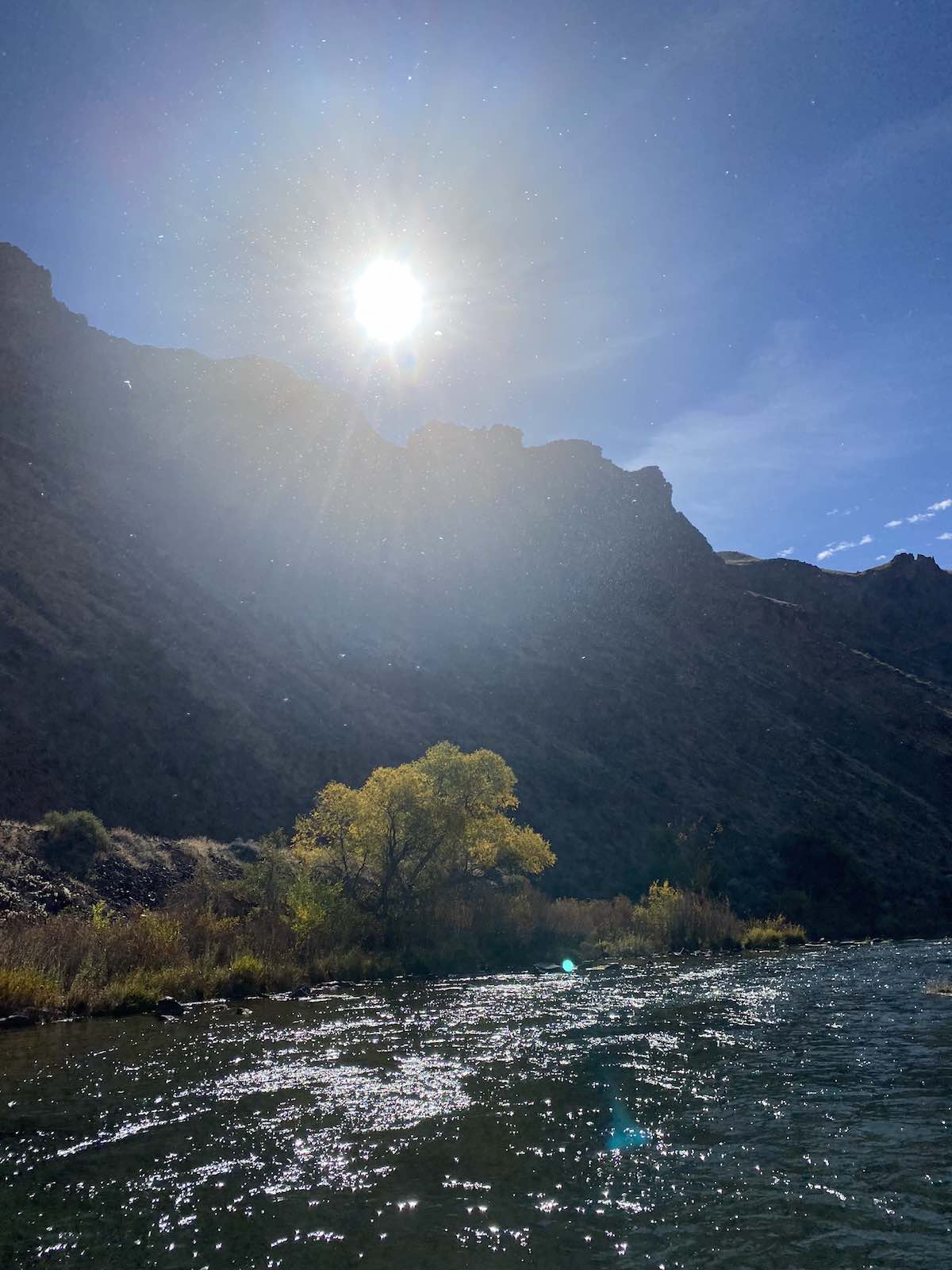
The above video shows the same BWO cloud, but you can see much more detail.
How to Fly Fish a BWO hatch
I mentioned earlier that blue winged olives hatch year-round, which is great. But, it gets crazier.
BWOs actually prefer to hatch during weather that would keep a lesser fly angler at home. Not you or me, though.
Specifically, you’ll experience the heaviest blue winged olive hatches during rainy, snowy, cloudy, and windy weather conditions. If it’s clear and sunny, the hatch will be minimal or even non-existent.
They tend to hatch at two different times during the day: early morning and late afternoon. These are the best hatch windows to focus on.
Occasionally hatches will be so heavy that it actually makes your fly fishing more challenging because the river’s surface is coated with tens of thousands of baetis mayflies. Trout can eat to their heart’s content and, from a pure numbers standpoint, will likely not zero in on your BWO fly tied with feathers.
But, massive hatches are the exception, not the norm, on most rivers.
Here’s a solid brown trout I landed on a size 22 blue winged olive dry fly pattern in January during a modest hatch.
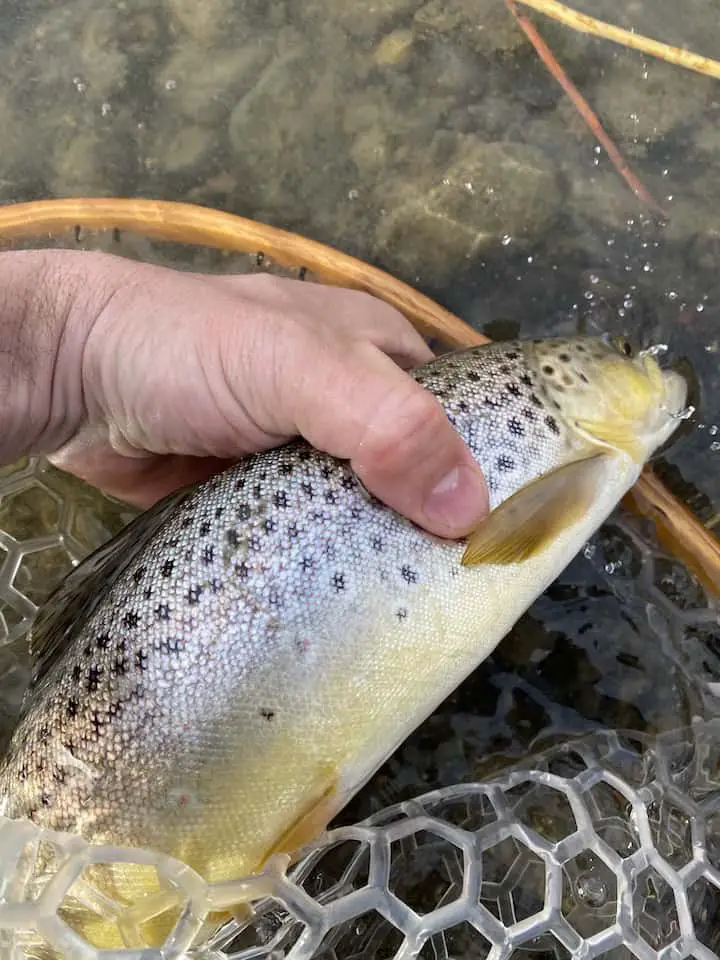
Conventional fly fishing wisdom says that BWOs won’t hatch below 40F.
Experience has taught me that’s just wrong. Totally inaccurate.
I’ve been in the midst of BWO hatches during winter temperatures of 32F to 39F plenty of times.
When you hit the river, watch for rising fish. This means keep a look out for the dimples they make on the water’s surface when they rise to an insect. You can often see and hear the rises.
If you find yourself in the middle a blue winged olive hatch, zero-in on the size of the mayflies.
Instead of worrying about which variation of BWO dry fly pattern to use, try to make sure you get the size right when selecting your fly.
Most BWO flies are in the size range of 18-26. These can be nymphs, emergers, or adult patterns. (I’ll cover the best BWO flies in the next section.)
If there are no rising trout, you may want to try using nymphs under an indicator, or even a dry-dropper setup (a buoyant dry fly trailed by a nymph).
But again, if you see rising trout, try to determine what exactly they’re eating. Watch closely.
If the trout are eating just below the surface, they’re taking emergers–the BWOs that are trying to get to the surface to shed their exoskeleton (shuck) dry their wings, and fly away. In this case, you’d use an emerger pattern.
But if you’re seeing adult blue winged olives floating on the surface and disappearing with each rise, you know they’re taking adult baetis. So, you’d use an adult dry fly pattern.
If the air is damp or wet, it’ll take longer for their wings to dry.
Here’s another feeding trout, this time a brown (Salmo trutta), that fell for one of my size 18 BWO mayfly imitations on a chilly day in March.
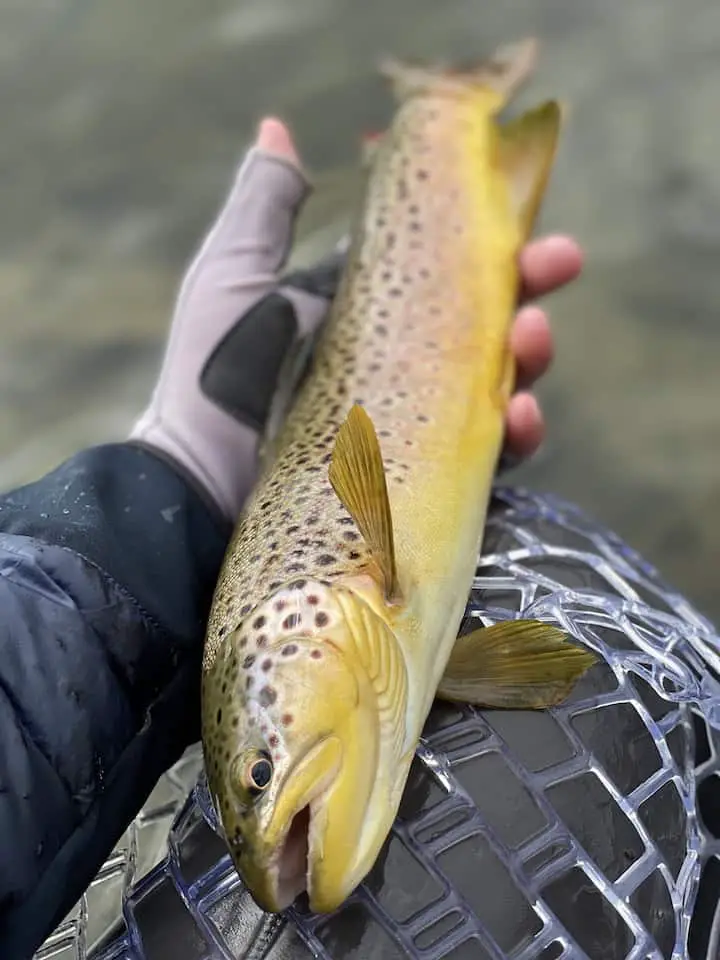
The Best BWO Fly Patterns
BWO CDC Spinner Dry Fly (adult)
This fly has caught me plenty of fish, mostly rainbows and browns. Use this fly when you see spent (dead) baetis floating on the water’s surface. The spinner phase, as you recall, is their final life phase, right after mating and laying eggs.
Parachute BWO (adult)
Along with the standard blue winged olive dry fly (adult phase), which is a must-have pattern for all fly anglers, I often use the parachute version as well. It sits lower on the water, and sometimes that makes all the difference. It’s also much easier to see in low light conditions when the water has that challenging glare.
Klinkhammer BWO (emerger)
If trout around you are hitting emergers, this is a great fly to use. Time tested and super productive. The rear of the fly rests below the water’s surface, which is ideal for these situations.
Sparkle Dun BWO (emerger)
The sparkle dun may be the best fly you’ve never used. It’s one of my go-to patterns when trout are taking emergers. Get a few and you can thank me later.
Pheasant tail nymph / Hare’s Ear Nymph
These aren’t BWO nymph patterns, they’re better.
There isn’t a nymph in existence that’s going to outperform a pheasant tail, and a hare’s ear isn’t far behind. Both of these patterns will work well when trout are taking blue winged olive nymphs below the surface.
There are specific BWO nymph flies you can buy, but in my experience they don’t stack up against these two patterns.
The below picture shows a notably long brown trout I landed using a size 22 BWO emerger pattern in October.
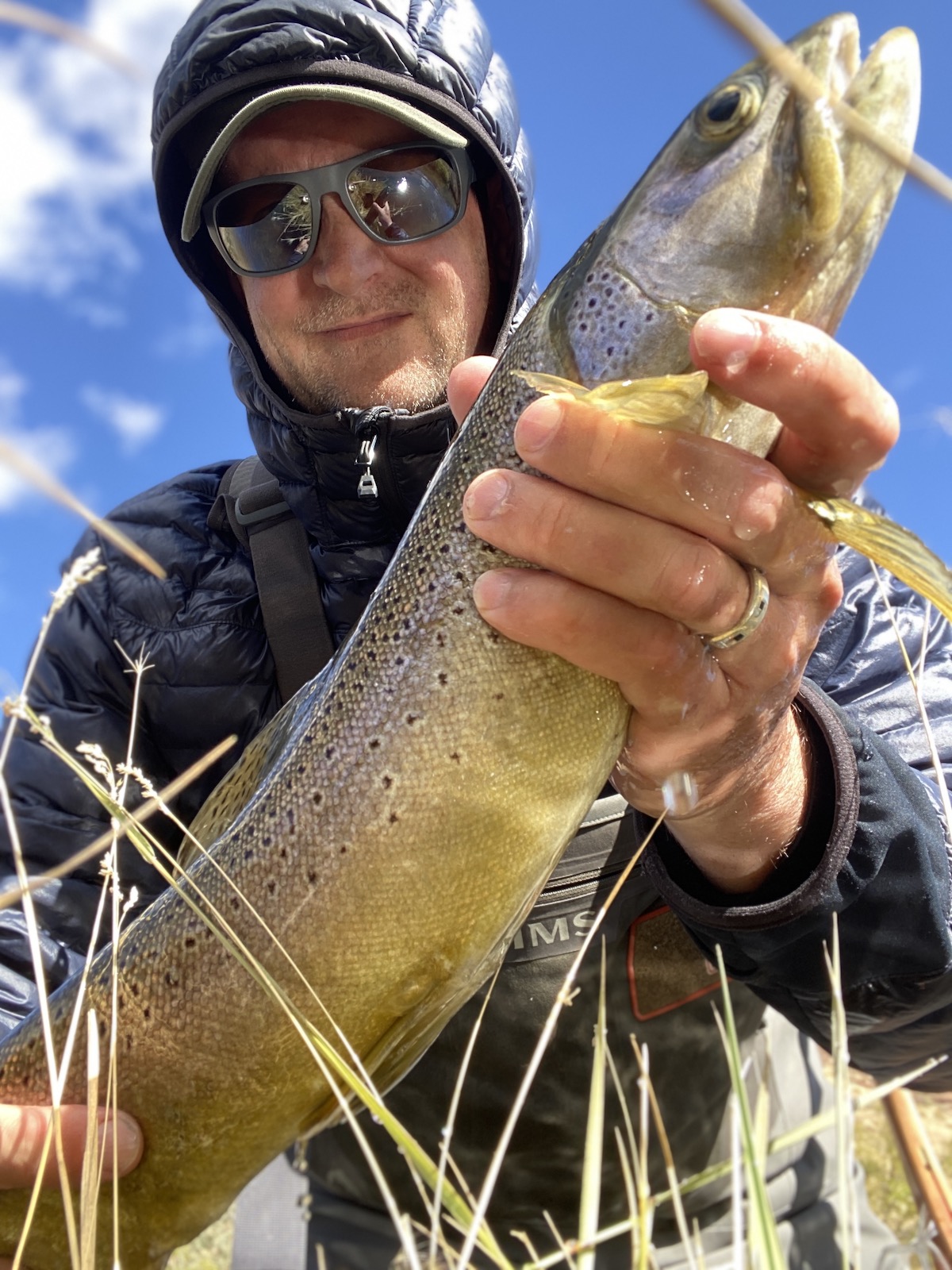
Common BWO Species
Here’s a list of the blue winged olive mayfly species you’re most likely to encounter on rivers in the United States:
Baetis tricaudatus – This species’ range extends across all of Canada, the U.S., and Mexico.
Baetis brunneicolor – This species is found throughout Canada, and also in the Southeastern and Northern U.S.
Diphetor hageni – These mayflies are distributed throughout all of Canada, and most of the U.S. from coast to coast.
Labiobaetis propinquus – These BWOs are found across the eastern half of Canada, as well as throughout most of the U.S.
Acerpenna pygmaea – These blue winged olives are found across all of Canada and the U.S., with the exception of a few western states.
Summary
Blue winged olives are the most prolific mayflies in North America, and are a foundational insect of focus for fly fishing enthusiasts.
You now know what BWOs look like, where to find them, their life stages, and how to fly fish successfully when they’re hatching.
Any angler worth his or her salt will need to become very familiar with this important insect.
Whether you refer to them as baetis, baetids, or blue winged olives, they’re my favorite bugs on the river.
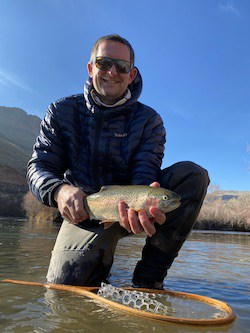
About the Author
My name's Sam and I'm a fly fishing enthusiast just like you. I get out onto the water 80+ times each year, whether it's blazing hot or snow is falling. I enjoy chasing everything from brown trout to snook, and exploring new waters is something I savor. My goal is to discover something new each time I hit the water. Along those lines, I record everything I learn in my fly fishing journal so I can share it with you.
Follow me on Instagram , YouTube, and Facebook to see pictures and videos of my catches and other fishing adventures!
